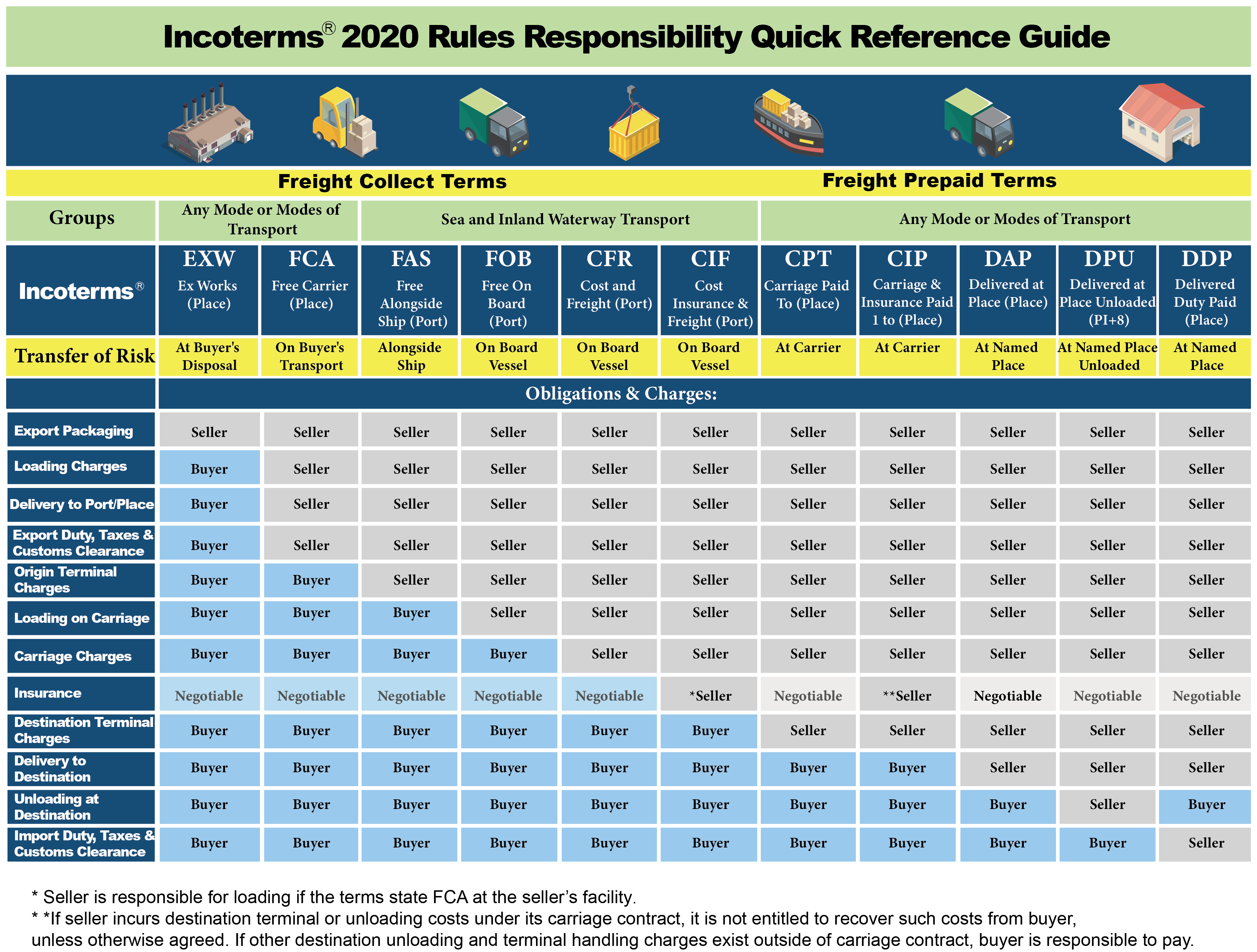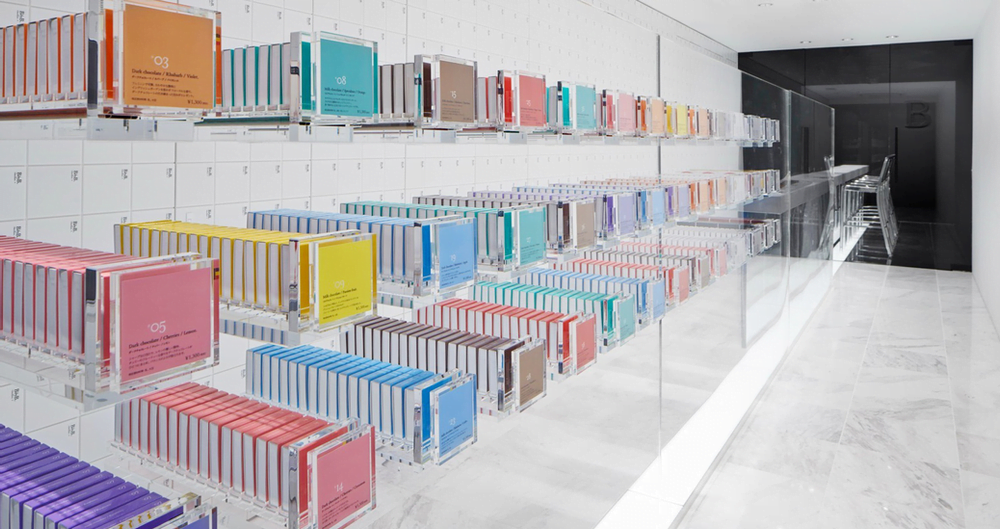This article focuses on international trade terms and the main international trade payment methods.
Table of Contents
Due to the COVID-19, global manufacturing is more concentrated in China at this stage. Our retail display manufacturing industry is no exception, but many of our customers are still confused about Incoterms and payment methods.
International Trade Terms
Incoterms 2020 Rules Responsibility Quick Reference Guide provides specific guidance for our participation in global trade imports and exports.
EXW – Ex Works (…. named place of delivery)
The Seller’s only responsibility is to make the goods available at the Seller’s premises. The Buyer bears full costs and risks of loading and moving the goods from there to the destination, including arranging for the export clearance. It is not recommended for international moves.
FCA – Free Carrier (…named place of delivery)
Delivery is made either when goods are (1) loaded on the means of transport provided by the buyer at the seller’s stated location; or (2) when placed at the disposal of the buyer’s carrier, cleared for export by the seller. From either point of delivery, the Buyer bears the costs and risks of moving the goods to the destination. The named place/address is required when FCA is used.
FAS – Free Alongside Ship (…named wharf/seaport)
The Seller delivers the goods to the buyer when the goods are cleared for export and then placed alongside the ship nominated by the buyer at the named port of shipment. From that point, the Buyer bears all costs and risks of loss or damage.
FOB – Free on Board (…named wharf/seaport of shipment)
The Seller delivers the goods to the buyer on board the vessel nominated by the buyer, cleared for export, at the named wharf/seaport of shipment. From that point, the Buyer bears all costs and risks of loss or damage.
CFR – Cost and Freight (…named wharf/seaport of destination)
The Seller delivers the goods to the buyer on board the vessel, cleared for export to the named port of destination. The Buyer bears all risks of loss or damage once onboard. Where more than one mode of transport is to be used, such as when goods are handed over to a carrier at a container terminal, it is highly recommended to use CPT instead.
CIF – Cost Insurance and Freight (…named wharf/seaport of destination)
The Seller delivers the goods to the buyer on board the vessel, cleared for export to the named port of destination. The Buyer bears all risks of loss or damage once on board. The Seller, however, purchases the cargo insurance to the named wharf/seaport of destination. Where more than one mode of transport is to be used, such as when goods are handed over to a carrier at a container terminal, it is highly recommended to use CPT instead.
CPT – Carriage Paid To (…named place of destination)
The Seller delivers and transfers the risk of loss or damage by handing over goods to the carrier chosen by the seller, cleared for export, who pays for moving the goods to the named place of destination. From the time the goods are transferred to the first carrier, the Buyer bears the risks of loss or damage.
CIP – Carriage and Insurance Paid To (…named place of destination)
The Seller delivers and transfers the risk of loss or damage by handing over goods to the carrier chosen by the seller, cleared for export, who pays for moving the goods to the named place of destination. From the time the goods are transferred to the first carrier, the Buyer bears the risks of loss or damage. The Seller, however, purchases cargo insurance thru to the named place of destination.
DAP – Delivered At Place (…named address/place of destination)
The Seller delivers when the goods are placed at the Buyer’s disposal on the arriving means of transport ready for unloading at the named place of destination or at the agreed point within that place if any such point is agreed. The Seller bears all risks involved in bringing the goods to the named place. Delivery & Arrival at the destination is the same.
DPU – Delivered at Named Place, unloaded (named address/place of destination)
The Seller delivers when the goods, once unloaded from the arriving means of transport, are placed at the Buyer’s disposal at a place of destination. The Seller bears all risks involved in bringing the goods to and unloading them at the terminal at the named port or place of destination. DPU is the only Incoterms where the Seller must pay for unloading at the destination. As the seller is responsible for unloading the goods at the destination it is highly recommended to be as specific as possible as to the named address/place of destination as all costs thru to unloading are for the seller’s account.
DDP – Delivered Duty Paid (…named address/place of destination)
The Seller delivers the goods to the buyer when the goods are placed at the disposal of the buyer, cleared for import, on the arriving means of transport, ready for unloading, at the named place of destination. The Seller bears all costs and risks of moving the goods to the destination, including the payment of Customs duties and taxes. There are limitations to DDP, as Customs formalities in the importing country may not readily allow the seller to be the legal importer of record; DAP or DPU have suggested Incoterms in such cases.
Our company is currently doing mostly EXW, FOB, CIP, DDU, and DDP, so if you have any new ideas, please feel free to discuss them together.
Payment Methods

There are also a variety of payment methods. Regarding foreign trade payments, two concepts are often confused: receipt of foreign exchange collection and remittance.
The way of receipt foreign exchange collection refers to the channel of collecting US dollars, for example, a small amount (proofing fee) with PayPal, west union; collect large amount with we will use US dollar account, Hong Kong account or Ali’s credit insurance, etc.
There are three main forms of payment in foreign trade: Transfer, Letter of Credit, and Collection.
Transfers
There are Telegraphic Transfer (TT) and Mail Transfer. Nowadays, we mainly use TT, which is divided into TT in advance (Payment in full prior to shipment) and full payment within xx days after the B/L date. To balance the security and convenience of both buyers and sellers, a combination of the two is now generally used, for example, T/T 30% before shipment. 70% at sight of copy of B/L.
Letter of Credit (L/C)
L/C is a written guarantee issued by an issuing bank to a third party at the request and at the direction of the applicant containing a certain amount of money to be paid within a certain period based on conforming documents. A letter of credit is the main and most used form of payment in international trade.
Collection
In the import and export trade, the exporter issues a bill of exchange payable to the importer and entrusts the exporter’s bank to collect payment from the importer through its branch or correspondent bank on the import side. It includes D/P (Delivery of Payment), and D/A (Delivery of Acceptance).
Open Account (OA)
In addition to these three main payment methods, more and more customers are now asking for Open Account (OA)
OA payment is the riskiest form of payment for suppliers, but when used well it can be a major advantage for suppliers. How to use OA as a payment method?
Using OA as a payment method, the biggest problem is risk control, we can transfer the risk with the help of insurance companies; good credit for old customers, and customers who keep returning orders all year round can use the OA payment method.
To read more blog posts about retail display click here.
If you have any questions regarding the import of retail display products pop display from China, please message me or [email protected] | whatsapp:+8618948317476





